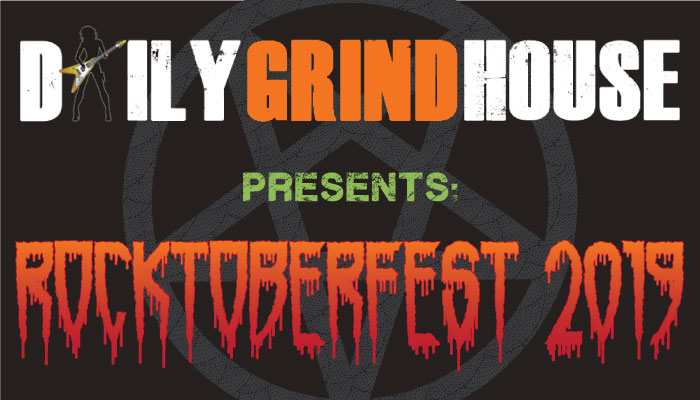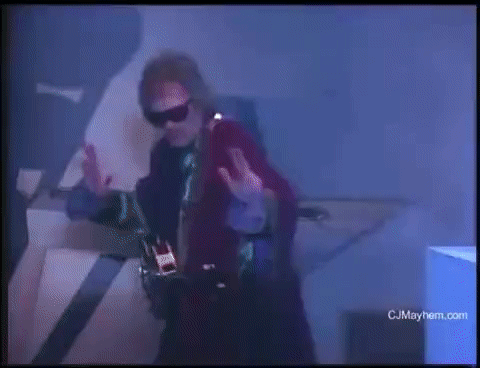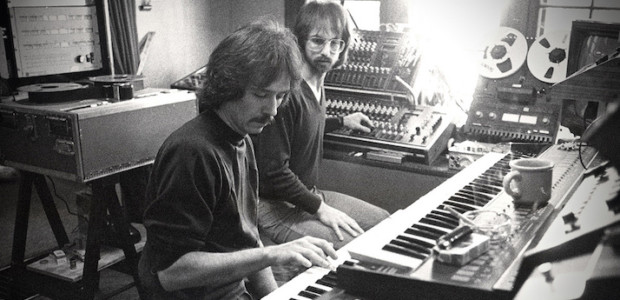 The Big Question is where multiple Daily Grindhouse contributors and friends offer their answers to some burning question. In observance of Rocktoberfest 2019, all of October’s questions will be about the intersection of horror and music. Check in every Friday afternoon in October to see what some of your favorite writers have to say. The results…may surprise you.
The Big Question is where multiple Daily Grindhouse contributors and friends offer their answers to some burning question. In observance of Rocktoberfest 2019, all of October’s questions will be about the intersection of horror and music. Check in every Friday afternoon in October to see what some of your favorite writers have to say. The results…may surprise you.
Today’s big question is…
What is your favorite John Carpenter score?
John Carpenter has scored a lot of films in his days (often with a collaborator), though he was not the composer for all of his films (STARMAN, THE THING). From his student film-turned-feature debut DARK STAR through the work he did on HALLOWEEN (2018) with his son (Cody Carpenter) and Daniel Davies, it seems this master of horror’s streak of great and influential movies has only been matched by his endlessly listenable (and also guiding) scores. But…which is your favorite and why?

Tisha from My Ghoulish Adventures — HALLOWEEN (1978)
When I think of bone-chilling scores that sparsely manage to set a tone almost without trying, I always go back to the moment in time that I heard a song that worked like a marriage with cinema — the main theme from HALLOWEEN (1978). Maybe it’s a biased point of view since it’s been my ringtone for ten years, or maybe it’s the reality of how much of a game changer the movie and its score would captivate the world. Its piano melody was a reminder of a dicey sound, almost like the sound of Michael Myer’s knife, slashing you to a consistent beat. As if this soundtrack was the Mecca for perfection, John Carpenter would return to this franchise with HALLOWEEN II, HALLOWEEN III: SEASON OF THE WITCH, and HALLOWEEN (2018). While the catchiest song from those scores would be the recycled ‘London Bridge is Falling Down” song for Silver Shamrock, the entire HALLOWEEN III score itself introduced a synth wave to his expanding resume of capturing suspense in a changing demographic, all while feeding strong chords to hit you right in the nostalgia for years to come.
Nathan Smith — THE FOG (1980)
Without a doubt, my favorite John Carpenter film is THE FOG. I know that’s not the question posed this week, but I’m getting to that. When Halloween rolls around, one would think the easy choice for film watching would be 1978’s HALLOWEEN. But it’s just that, the easy choice. Why wouldn’t you watch a vicious, violent, atmospheric ghost story when the spookiest time of the year rolls around on our calendar? So I watch THE FOG on October 31st. Because Carpenter’s score is so central to making his 1980 classic an effectively chilling tale, my favorite John Carpenter score is THE FOG, because it is such a driving, pulsing score that perfectly encapsulates the haunting at the core of its story. His piano plinking propels you through the nightmare of Antonio Bay. Never has music so adequately thrived with the feeling of a cold, waterlogged death. Carpenter’s organ roars like a crashing wave against the shore, serving as the primal scream of Blake and his gaggle of vengeful pirates that they will never vocalize. There are three different versions of Carpenter’s score, so get out there, slap your headphones on and let your skin crawl.
Stephanie Crawford — ASSAULT ON PRECINCT 13 (1976)
As a complete idiot when it comes to film scores, I appreciate how singular and recognizable John Carpenter’s music is. That’s one of the reasons it’s also hard to pick one favorite, but mine finally comes down to ASSAULT ON PRECINCT 13. Performed with constant chum Tommy Lee Wallace, Carpenter apparently wrote it quickly, and it’s definitely more economic than it is showy. That opening theme is as memorable as the opening bars of HALLOWEEN’s theme to me, though, and I find myself randomly humming it to myself?. As the song goes on, though, the background synthesizers gently swell and sound as though they’re growing in a sympathetic kind of way, almost pleading. I also love the track “Julie,” which is a subtle, beautiful piece that would fit comfortably on Air’s Moon Safari album. Tough and tender, this score is the sonic version of the idealized “tough guy with a heart of gold” movie boyfriend.
Here’s the video I personally took when I saw him live!
Bill Bria — HALLOWEEN III: SEASON OF THE WITCH
1982’s HALLOWEEN III: SEASON OF THE WITCH is still a divisive entry in the primarily Michael Myers slasher series, but its sick-joke apocalyptic tale has grown in appreciation over the last few decades. One element of the movie that was virtually always admired is John Carpenter and Alan Howarth’s score, which in my opinion is their greatest collaboration. The film concerns an Everyman doctor, Daniel Challis (Tom Atkins) who stumbles upon an insidious plot by a Halloween mask manufacturer-cum-warlock, Conal Cochran (Dan O’Herlihy) to sacrifice as many children on Halloween night as possible with a mix of old black magic and then-state-of-the-art technology. The blend of spooky old-world atmosphere with futuristic tech is echoed and amplified in Carpenter & Howarth’s score, as they play all their ominous arrangements through the unnatural tones of their synthesizers. Cues like “Drive to Santa Mira” use a pop-like rhythm that features a descending, spooky melody, almost as if John Lennon’s “Imagine” was a demonic incantation. “Chariots of Pumpkins” cheekily references the Vangelis title track for CHARIOTS OF FIRE (1981), borrowing a bit of that tune’s driving rhythm, crafting a synth-y groove all its own that recalls the unstoppable automatons in the film, as well as the final TV commercial that will bring certain death. That commercial and its attendant jingle, a reworking of the traditional “London Bridge” tune, has become the movie’s most enduring element, and with good reason, as its sickly warble both satirizes ‘80s commercialism while hinting at the sinister purpose underneath. Its constant use in the movie also ensures that Carpenter & Howarth’s stellar work is not easily forgotten.
John Rieber — CHRISTINE
CHRISTINE Puts A Spell On You! As we celebrate the film scores of John Carpenter, I wanted to look at a film that utilizes two separate soundtracks. In 1983, Carpenter took Stephen King’s latest horror sensation, Christine, and turned it into one of his most enduring films. Keith Gordon stars as a nerd who is being bullied at school…but when he buys a car that has an evil personality, he comes under its spell and vengeance begins. Two albums were released for the film—one showcasing the score, written and composed by John Carpenter and Alan Howarth, the other being the soundtrack full of hit songs from the ‘50s. When we open the film in the car assembly line, what song is playing as Christine is revealed? “Bad To The Bone.” Later in the film, as Gordon’s girlfriend is trapped in the car choking, the radio plays “We Belong Together.” Carpenter and Howarth’s original score, with synthesizers, electronics, and moog organ heard throughout. It’s subtle and atmospheric, setting a tone of dread…an echo of Carpenter’s iconic HALLOWEEN score is there as well. Carpenter tells much of the story through the use of those classic songs and his moody score. While it may not exude John Carpenter’s directorial flourishes, the music makes it clear that it’s got his signature groove.
Samantha Schorsch — HALLOWEEN (2018)
The original HALLOWEEN soundtrack is a seminal horror soundtrack. It manages to be tense, piercing, and anxiety inducing in so many forms all at the same time. I was sure nothing could top it; until HALLOWEEN (2018). Composed with collaborators Cody Carpenter and Daniel Davies, the score for HALLOWEEN (2018) combines the iconic melodies and sensibilities of the original film and tweaks them for a modern setting without sounding overdone or overly electronic as some soundtracks of our current era tend to be. The best example of this, in my opinion, would have to be “The Shape Returns.” It begins with the classic Shape theme, and then after an interlude of frenetic procussions goes into an electronics enhanced revamp of the theme melded with a ticking clock as the Strode family’s time runs out before fading back into a heavier blend of the original musical cues one more time, bookending the new with the old. It’s a fabulous work of sonic storytelling and a perfect example of why John Carpenter is treated like the legend he is.
Jay Alary — THE FOG (1980)
John Carpenter’s original HALLOWEEN score is beloved for all the right reasons, his main themes for ASSAULT ON PRECINCT 13 and ESCAPE FROM NEW YORK are often stuck in my head, but my favourite Carpenter score is for THE FOG. A synth score might seem like an unusual choice for an old-fashioned ghost story of vengeful spectres descending upon a Northern California seaside town with a fog bank, but I think it’s fitting. A doleful dose of piano melancholy establishes the film’s tone immediately in the prologue, in which a seasoned fisherman (John Houseman) captivates some children with a fireside tale of Antonio Bay’s tragic history. The tale completed, Carpenter’s thundering synthesizer signals the transition from the past to present as the title sequence begins (the music is not unlike an old Catholic Church organ, which is a bit of foreshadowing, as Antonio Bay’s Father Malone plays a significant role in the plot). Carpenter’s score creates sombre tension and persistent dread, as the sinister fogbank envelopes Antonio Bay, the tempo increasing as characters frantically fend off ghostly fishermen. THE FOG’s score is one of Carpenter’s more subdued synth scores, but I think it’s one of his best compositions.
Jedidiah Ayres — BIG TROUBLE IN LITTLE CHINA
My wife and I don’t get out to see live music as often as we used to, and now when we do we’re more likely to be unfamiliar with the opening act, so I can’t for shit’s sake remember the name of the band opening for ol’ whose-its when we went to see ’em a couple years back, but they fucking ruled. I can’t tell you what they were called, but they were a bass-synth-drum trio and I described them for weeks afterward as playing a genre I called “John Carpenter Soundtrack,” and if you’re reading this here piece I bet you know exactly what they sounded like and why the hell I was into them. BIG TROUBLE IN LITTLE CHINA was my first Carpenter movie and I was obsessed with it from the first time I saw a trailer for it a few weeks before it came out till this day. The score isn’t as widely recognizable as say HALLOWEEN, and probably not the first recommendation I’d give to someone who wanted to understand the John Carpenter score genre, but it is absolutely the most evocative to me.
Kevin Maher — DARK STAR (1974)
GUARDIANS OF THE GALAXY got a lot of love for its ‘70s rock soundtrack, but John Carpenter paved the way in DARK STAR. The galactic comedy juxtaposes outer-space travel with a lonely country-western song. Instead of the synth sound that Carpenter is associated with, we hear a twangy cowboy tune that sets the stage for an existential, cosmic adventure. The 20th century country song grounds the story, reminding us that these astronauts come from the same place we do, and after being so far from home they long for the simple pleasures like feeling the warmth of the sun. It’s a simple and effective musical choice.
Rob Dean — CHRISTINE
I think when looking over these answers, a lot of people are going to mention two or three other scores in addition to their favorite. Carpenter has been so prolific with his filmmaking and musicianship that, even though they feel of the same cloth, they are very different entities that provide unique thrills and chilling moments. HALLOWEEN III: SEASON OF THE WITCH, PRINCE OF DARKNESS, and HALLOWEEN (2018) were close contenders—but ultimately it’s my favorite John Carpenter score is his work on CHRISTINE. “Moochie’s Death,” “Show Me,” and “Christine Attacks” are all stand out tracks that seem derived from a central theme, with methodical progression abutting against cacophonous screeching. The highlight for me, though, is “Football Run/Kill Your Kids” track—accompanying the scenes where Dennis is almost paralyzed on the field and the reveal that Arnie is beginning to give in to his darker self. The disparity between the patient, assured percussion before the spike in synthesizers is a perfect distillation of a Stephen King suburban story of the supernatural: at first it seems fine and dandy, until that horror bursts through the idyllic façade and starts laying to waste the status quo.
Matt Wedge — IN THE MOUTH OF MADNESS
I’m far from a music expert, but I know a Carpenter score when I hear one. That’s what makes the opening hard rock theme playing over the credits to IN THE MOUTH OF MADNESS so bracing: It does not sound like Carpenter–at all. Written with Jim Lang, the driving, guitar and drum heavy theme is the first sign that this film is Carpenter really flexing his filmmaking muscles beyond his usual (very good) siege-horror genre (although one could argue that it is a sort of siege film–just a very hallucinatory one) into the most expansive, horrifying, and playful film of his career.
Jon Abrams — PRINCE OF DARKNESS
Almost impossible to choose, but I’m going with PRINCE OF DARKNESS, because in my view it’s one of the least mentioned and definitely one of the few I haven’t written about yet. It warrants a deeper consideration, because I’ve long held the hunch it’s low-key one of John Carpenter’s most personal films and certainly one that encapsulates the wordview which unites the majority of his work.
One key is in the casting. PRINCE OF DARKNESS casts as its authority figures two of the most memorable and well-liked mentor figures from Carpenter’s filmography, one from his most successful film and one from his then-most-recent. Donald Pleasence is there representing spiritual rectitude and Victor Wong is there representing academia, and both of them fail in the face of the mounting horrors at the center of the story. There’s no sneering villain to murder and save the day here. The enemy is evil itself. How can any one person defeat that? How can a dozen? How can a billion? (No wonder, really, that this flick wasn’t a popular favorite and still isn’t. Nobody wants to hear that we all ultimately lose.)
A second key is auditory. The score for one of Carpenter’s more overlooked films, itself one of the more overlooked compositions he and vital collaborator Alan Howarth came up with, is low-key and rumbling and occasionally sad, until those moments where it erupts again…and then look out. Being the film and the score that directly followed BIG TROUBLE IN LITTLE CHINA, the score has some of the same propulsive qualities, but here we’re headed to a much darker place. This is a score with a track called “Hell Breaks Loose,” and when that comes, it’s exactly what it sounds like. For a perfect sampling of what I’m talking about, try “Team Assembly” and “Through The Mirror.”
Tags: Alan Howarth, assault on precinct 13, Christine, Dark Star, halloween, Halloween (2018), Halloween III: Season Of The WItch, in the mouth of madness, john carpenter, Prince of Darkness, Stephen King, Synthesizer, the fog, The Thing


No Comments